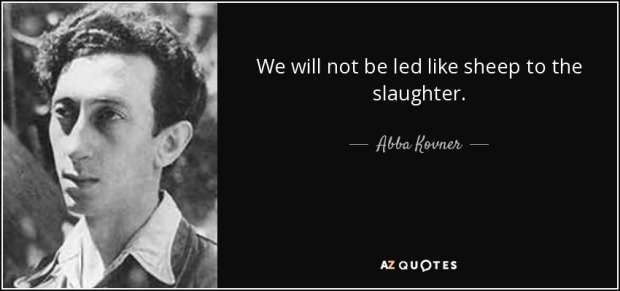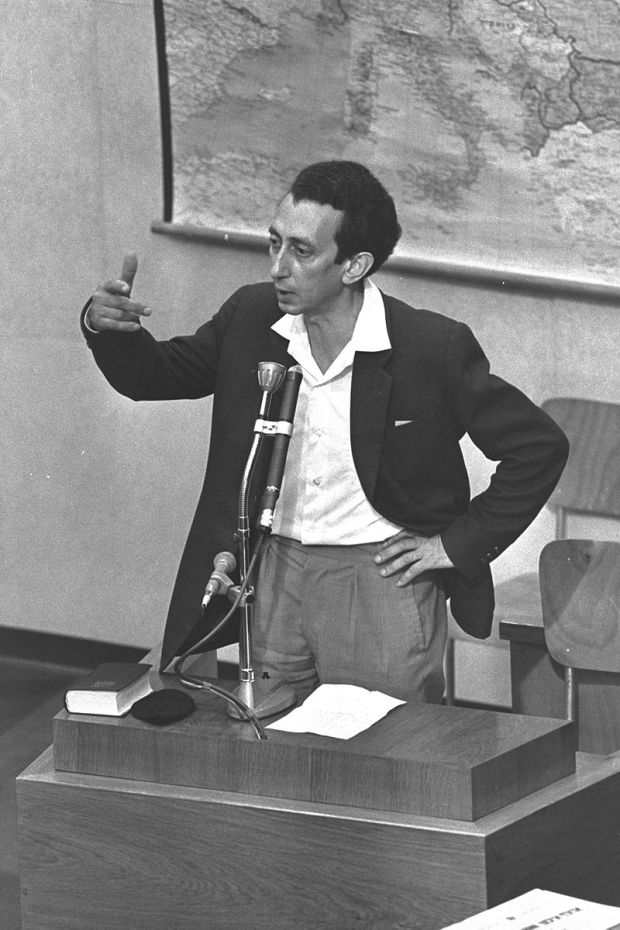
Abba Kovner was a somewhat controversial figure and by today’s standards he could be considered a terrorist, but as the saying goes “One man’s terrorist is another man’s freedom fighter” But considering what he witnessed one can not blame him for some of his actions after the war.
Abba Kovner was born on March 14, 1918, in the Crimean Black Sea port city of Sevastopol. His parents were Rachel (Rosa) Taubman and Israel Kovner. At a young age he moved with his family to Vilnius, which at this time was part of Poland, where he grew up and was educated at the secondary Hebrew academy and the school of the arts. While pursuing his studies, he joined and became an active member in the socialist Zionist youth movement HaShomer HaTzair.

In September 1939, World War II began. Only two weeks later, on September 19, the Red Army entered Vilna and soon incorporated it into the Soviet Union. Kovner became active during this time, 1940 to 1941, with the underground. But life changed drastically for Kovner once the Germans invaded.
On June 24, 1941, two days after Germany launched its surprise attack against the Soviet Union (Operation Barbarossa), the Germans occupied Vilna. As the Germans were sweeping east toward Moscow, they instigated their ruthless oppression and murderous actions in the communities they occupied.
Vilna, with a Jewish population of approximately 55,000, was known as the “Jerusalem of Lithuania” for its flourishing Jewish culture and history. The Nazis soon changed that.
As Kovner and 16 other members of the Ha-Shomer ha-Tsa’ir hid in a convent of Dominican nuns a few miles outside of Vilna, the Nazis began to rid Vilna of its “Jewish problem.”
Less than a month after the Germans occupied Vilna, they committed on of their first atrocities. Einsatzkommando 9 rounded up 5,000 Jewish men of Vilna and took them to Ponary (a location approximately six miles from Vilna that had pre-dug large pits, which the Nazis used as a mass extermination area for Jews from the Vilna area).
The Nazis made the pretense that the men were to be sent to labor camps, when they were really sent to Ponary and shot.
At the start of 1942, Kovner released a manifesto in the Vilnius ghetto, twice repeating the phrase “Let us not go like lambs to the slaughter!” that later became famous.The manifesto declared that Hitler had decided to kill all the Jews of Europe and that it was best to die fighting. It was the first time such a notion had been declared in Europe,nobody at that time knew for certain of more than local killing,and many received it with skepticism;however, for many this proclamation represented a turning point in an understanding of the situation and how to respond to it.
Kovner was responsible for writing a call to revolt. In front of the 150 attendees gathered together at 2 Straszuna Street in a public soup kitchen, Kovner read aloud:
Jewish youth!Do not trust those who are trying to deceive you. Out of the eighty thousand Jews in the “Jerusalem of Lithuania” only twenty thousand are left. . . . Ponar [Ponary] is not a concentration camp. They have all been shot there. Hitler plans to destroy all the Jews of Europe, and the Jews of Lithuania have been chosen as the first in line.
We will not be led like sheep to the slaughter!
True, we are weak and defenseless, but the only reply to the murderer is revolt!
Brothers! Better to fall as free fighters than to live by the mercy of the murderers.
Arise! Arise with your last breath!
At first there was silence. Then the group broke out in spirited song.
The idea of resistance was disseminated from Vilnius by youth movement couriers, mainly women, to the ghettos of occupied Poland, occupied Belarus and of Lithuania. Kovner, Yitzhak Wittenberg, and others formed the United Partisan Organization (“Fareynigte Partizaner Organizatsye”, or FPO), one of the first armed underground organizations in the Jewish ghettos under Nazi occupation.

Unlike in other ghettos, the resistance movement in the Vilna Ghetto was not run by ghetto officials. Jacob Gens, appointed head of the ghetto by the Nazis but originally chief of police, ostensibly cooperated with German officials in stopping armed struggle.
The FPO represented the full spectrum of political persuasions and parties in Jewish life.
The goals of the FPO were to establish a means for the self-defence of the ghetto population, to sabotage German industrial and military activities and to join the partisan and Red Army’s fight against the Nazis.
In early 1943, the Germans caught a member of the Communist underground who revealed some contacts under torture and the Judenrat, in response to German threats, tried to turn Yitzhak Wittenberg, the head of the FPO, over to the Gestapo.

Wittenberg was arrested by the Lithuanian police only to be freed by armed FPO members. He went into hiding in the ghetto, and the consensus of the ghetto’s population was that 20,000 people should not be jeopardized for the sake of one man.
Kovner became its leader in July 1943, after Wittenberg had turned himself in to prevent an attack on the ghetto.The FPO planned to fight the Germans when the end of the ghetto came, but circumstances and the opposition of the ghetto leaders made this impossible and they escaped to the forests.
From September 1943 until the arrival of the Soviet army in July 1944, Kovner, along with his lieutenants Vitka Kempner and Rozka Korczak, commanded a partisan group called the Avengers(“Nokmim”) in the forests near Vilna and engaged in sabotage and guerrilla attacks against the Germans and their local collaborators. The Avengers were one of four predominantly Jewish groups that operated under the command of the Soviet-led partisans.
After the occupation of Vilnius by the Soviet Red Army in July 1944, Kovner became one of the founders of the Berihah movement, helping Jews escape Eastern Europe after the war.
At the end of the war, Kovner was one of the founders of a secret organization Nakam (revenge), also known as Dam Yisrael Noter (“the blood of Israel avenges”, with the acronym DIN meaning “judgement”)whose purpose was to seek revenge for the Holocaust.Two plans were formulated. Plan A was to kill a large number of German citizens by poisoning the water supplies of Hamburg, Frankfurt, Munich, and Nuremberg, Nakam intended to kill 6 million Germans.Plan B was to kill SS prisoners held in Allied POW camps. In pursuit of Plan A, members of the group were infiltrated into water and sewage plants in several cities, while Kovner went to Palestine in search of a suitable poison. Kovner discussed Nakam with Yishuv leaders, though it is not clear how much he told them and he doesn’t seem to have received much support.According to Kovner’s own account, Chaim Weizmann approved the idea and put him in touch with the scientist Ernst Bergmann, who gave the job of preparing poison to Ephraim Katzir (later president of Israel) and his brother Aharon. Historians have expressed doubt over Weizmann’s involvement, since he was overseas at the time Kovner specified.The Katzir brothers confirmed that they gave poison to Kovner, but said that he only mentioned Plan B and they denied that Weizmann could be involved.As Kovner and an accomplice were returning to Europe on a British ship, they threw the poison overboard when Kovner was arrested. He was imprisoned for a few months in Cairo and Plan A was abandoned.
In April 1946, members of Nakam broke into a bakery used to supply bread for the Langwasser internment camp near Nuremberg, where many German POWs were being held.

They coated many of the loaves with arsenic but were disturbed and fled before finishing their work. More than 2,200 of the German prisoners fell ill and 207 were hospitalized, but no deaths were reported.
Kovner joined the Haganah(a Jewish paramilitary organization in the British Mandate of Palestine (1921–48), which became the core of the Israel Defense Forces (IDF).) in December 1947, and soon after Israel declared independence in May 1948 he became a captain in the Givati Brigade of the IDF.
During the Israeli War of Independence he became known for his “battle pages”, headed “Death to the invaders!”, that contained news from the Egyptian front and essays designed to keep up morale. However, the tone of the pages, which called for revenge for the Holocaust and referred to the Egyptian enemy as vipers and dogs, upset many Israeli political and military leaders.His first battle page started a controversy that still continues today when it accused the Nitzanim garrison of cowardice for surrendering to an overwhelming Egyptian force.
From 1946 to his death, Kovner was a resident of Kibbutz Ein HaHoresh.He was active in Mapam as well as in HaShomer HaTzair, but never took on a formal political role.He played a major part in the design and construction of several Holocaust museums, including the Diaspora Museum in Tel Aviv.

He died in 1987 (aged 69) of cancer that had started in his vocal cords, perhaps due to his lifelong heavy smoking. Vitka Kempner, who married Kovner in 1946, survived him.
Kovner’s book of poetry Ad Lo-Or, (“Until No-Light”), 1947, describes in lyric-dramatic narrative the struggle of the Resistance partisans in the swamps and forests of Eastern Europe.
Kovner’s story is the basis for the song “Six Million Germans / Nakam”, by Daniel Kahn & The Painted Bird.
Kovner testified about his experiences during the war at the trial of Adolf Eichmann.





You must be logged in to post a comment.